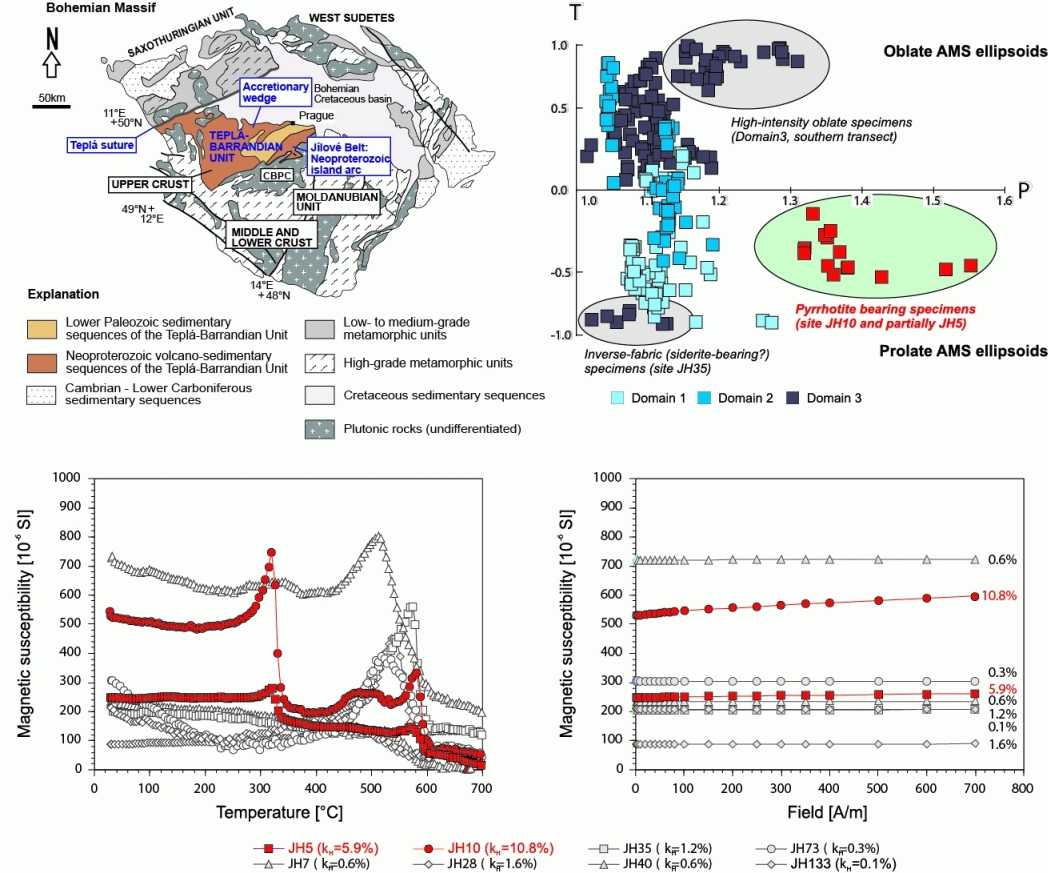Magnetic Mineralogy
Magnetic mineralogy (or magnetomineralogy) deals with the type, concentration and grain size of magnetic minerals with an aim to apply such information to magnetic prospecting, paleoclimatology, monitoring of environmental pollution or providing a basis for interpretation of paleomagnetic results where a magnetization stable over a long time span is highly desired. Due to the sensitivity of the state-of-the-art instruments, the magnetic measurements are nowadays applicable to virtually all materials, i.e. rocks, soils or even organic materials, including those whose magnetism is so weak that they are commonly considered as non-magnetic. Applying AGICO instrument to magnetic mineralogy, we can measure two basic but invaluable magnetic properties: low-field magnetic susceptibility and remanent magnetization.
Case study

The identification of pyrrhotite as the carrier of prolate, high-degree magnetic fabric in the flysch-like sediments of the Teplá-Barrandian Unit, Bohemian Massif.
When investigating the magnetic fabric in the Neoproterozoic graywackes and siltstones, several different fabric types of were indentified based on its magnitude and symmetry. Besides a commonly-observed, phyllosilicate-carried fabric characteristic for deformed sedimentary rocks (medium-degree, oblate or prolate), both high-degree oblate and prolate fabrics was observed. While the oblate fabric can be artibuted to the zones of higher deformatrion, the high-degree prolate fabric (highlighted in red) is rather difficult to be achieved in rocks where the fabric is solely carried by the oblate-fabric phyllosilicate grains. Using an AGICO Kappabridge coupled with a CS-4 temperature control unit, magnetic susceptibility was measured as a function of temperature and amplitude of applied AC field. Both rock magnetic methods independently identified the presence of pyrrhotite based on its Curie point and a pronounced increase of susceptibility as a function of field, respectively. Resulting from this simple test, pyrrhotite-bearing specimens must be excluded from the entire sample set when magnetic fabric is interpreted in terms of strain variations in the studied geological unit. Courtesy J. Hajná.
Magnetic susceptibility very sensitively reflects any slight variations in types and concentration of magnetic minerals further exceeding the capability of most conventional analytical methods. Its analytical power can be further extended when it is measured as a function of temperature, amplitude of the applied field, or at various operating frequencies. Measurements of bulk magnetic susceptibility can be very precisely performed using the latest state-of-the-art AGICO Kappabridges (current models are MFK2 and KLY5) with an optional addition of the low- or high temperature control units (current models are CS4 and CS-L, respectively) allowing to measure the temperature variations of magnetic susceptibility in the range from liquid nitrogen up to 700 ℃. Field or frequency-dependent magnetic susceptibility data can be very easily processed and visualized by AGICO Safyr software, temperature dependence of magnetic susceptibility is processed using Cureval software.
In addition to magnetic susceptibility, we can measure the artificial remanent magnetization, either isothermal (IRM) or anhysteretic (ARM), laboratory imparted in various fields, usually much stronger than the Earth's magnetic field. For that purpose we can conveniently employ an AGICO Spinner Magnetometer (current models are JR-6 / JR-6A) which is especially designed to measure a remanent magnetization of rock, soil and environmental samples of whatever origin, either natural or artificially modified or imparted during laboratory experiments. To demagnetize or magnetize the samples we can employ an AF Demagnetizer/Magnetizer (current models are LDA5 / PAM1) or any other commercially available or custom-built demagnetizer and/or magnetizer. The LDA5 / PAM1 is able to demagnetize samples with the maximum AC field of 200 mT; ARM can be imparted in a bias DC field up to 500 µT, alternatively in a certain coercivity window only (partial ARM). Low-field IRM can be imparted in DC field up to 20 mT with variable length of pulses from 10 ms up to 10 s. Rock magnetic data can be very easily processed and visualized by AGICO Remasoft software which gained a wide popularity due to its easy-to-control and straight forward user interface.
The applications of AGICO instruments in magnetomineralogic research are really manifold. To name just a few:
- Measuring magnetic susceptibility as a function of temperature in order to determine Curie/Néel points of ferromagnetic (sensu lato) minerals or to separate ferromagnetic / paramagnetic contribution.
- Measuring magnetic susceptibility as a function of the AC applied in order to identify the presence of ferromagnetic minerals possessing the low-field hysteresis, mainly pyrrhotite or titanomagnetite.
- Measuring magnetic susceptibility at various operating frequencies or decomposed into the in-phase and out-of-phase components with an aim to assess the presence of the ultrafine ferromagnetic particles important in environmental research.
- Calculation of the medium destructive field during a step-wise AF demagnetization of natural or artificially-magnetized samples and thus obtaining the first-hand idea whether we deal with magnetically "soft" and "hard" material.
- Performing the step-wise acquisition ARM or IRM and back field IRM acquisition with an aim to obtaining the coercivity of remanence, saturation remanence (SIRM) or various non-saturated remanence values (IRM).
- Calculation anhysteretic susceptibility which sensitively reflects single-domain material, particularly magnetite and maghemite.
- Calculation of the Koenigsberger ratio (Q-ratio) - the ratio of the remanent magnetization to the induced magnetization (product of susceptibility and the Earth's magnetic field strength). A large Q-ratio indicates that the magnetic material will tend to maintain significant remanent magnetization and indicates small mineral grain size. Q-ratio is very useful in interpretation the cause of magnetic anomalies.
- Calculation of the coercivity sensitive parameters, e.g. S-ratio, ARM/SIRM ratio, enabling to distinguish between magnetite- and hematite-dominated samples.
- Measuring stepwise thermal demagnetization of a composite IRM with an aim to distinguish between high-, intermediate-, and low-coercivity magnetic phases. This experiment requires a magnetically shielded oven.
- Investigation of artificially imparted viscous IRM as a function of DC pulse length and its decay as a function of time with a direct application to quantification of the amount of particles on the superparamagnetic/stable single-domain boundary even for very weakly magnetic rocks for which the traditional approach based on the frequency-dependent magnetic susceptibility fails.
